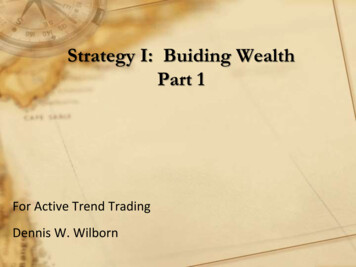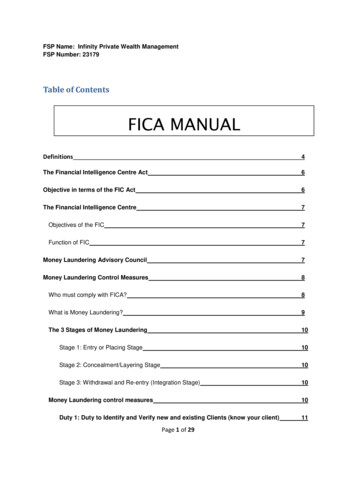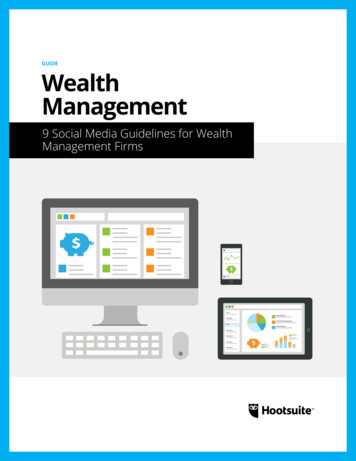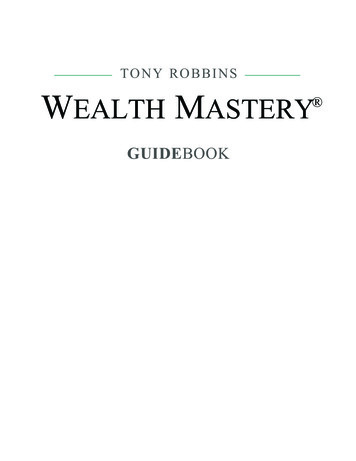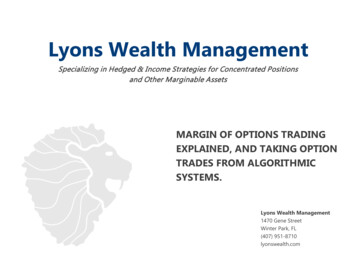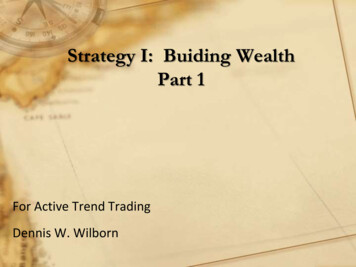
Transcription
Strategy I: Buiding WealthPart 1For Active Trend TradingDennis W. Wilborn
Disclaimer U.S. Government Required Disclaimer – Commodity Futures Trading Commission Futuresand Options trading has large potential rewards, but also large potential risk. You must be aware of the risks and be willingto accept them in order to invest in the futures and options markets.Don’t trade with money you can’t afford to lose. This is neither a solicitation nor an offer to Buy/Sell futures or options. Norepresentation is being made that any account will or is likely to achieve profits or losses similar to those discussed in thistraining. The past performance of any trading system or methodology is not necessarily indicative of future results. CFTC RULE 4.41 – HYPOTHETICAL OR SIMULATED PERFORMANCE RESULTS HAVE CERTAINLIMITATIONS. UNLIKE AN ACTUAL PERFORMANCE RECORD, SIMULATED RESULTS DO NOTREPRESENT ACTUAL TRADING. ALSO, SINCE THE TRADES HAVE NOT BEEN EXECUTED, THE RESULTSMAY HAVE UNDER-OR-OVER COMPENSATED FOR THE IMPACT, IF ANY, OF CERTAIN MARKETFACTORS, SUCH AS LACK OF LIQUIDITY. SIMULATED TRADING PROGRAMS IN GENERAL ARE ALSOSUBJECT TO THE FACT THAT THEY ARE DESIGNED WITH THE BENEFIT OF HINDSIGHT. NO REPRESENTATION IS BEING MADE THAT ANY ACCOUNT WILL OR IS LIKELY TO ACHIEVE PROFITOR LOSSES SIMILAR TO THOSE SHOWN. All Materials presented are for training purposes only. Traders should paper trade any new method prior to risk ofpersonal capital.Copyright ATTS 2007-2015
Where Wealth BeginsLast month Lee Tanner presented his Model Portfolio based ontrading IBD Quality Stocks from the IBD 50, Leaderboard, SectorLeaders Points Lee Made that Resonated:1. Stay Fully Invested—100% Margin2.Trade a Solid System that will take you in and out off the market at the RightTime3.True Wealth is generated by working a Portfolio Building Plan—Strategy I,and doing it again and again and again!4.Patience, Persistence, Discipline, Confidence, Compounding5.Some Stocks Work, Some Don’t—Fire the ones that don’tBonus Training: ordings/Copyright ATTS 2007-2015
Strategy I: Building WealthBuilding Wealth Requires a Plan1. A Plan based on a sound strategy to Get In2. A Management Plan to Get OutThe skills to build wealth can be developed in almost everyone!It takes understanding how to enter properly, exit properly andthe power of CompoundingCopyright ATTS 2007-2015
Strategy I: Building WealthIt’s a state of mind! It’s having a plan! It’s practicing the plan!Momentum Master’s: A Roundtable Interview with Super TradersMark Minervini, David Ryan, Dan Zanger, Mark Richie IIInteresting Facts:- Each Blew Up accounts while learning- One blew out his account, sold his car for a stake- Favorite entry of each—Pullbacks and bounces- Each defined an entry target—entering the trade on their terms- Each had to get past their egos- Each said the learning curve to become a good traders is between 3-5 yearsor longer depending on how learnable a person is- Each patiently worked with a system and plan—refined but didn’t change- Each plans their trades during non-market hours—no “seat of the pants”trading- Very Rarely Trade Options—Too Many VariablesCopyright ATTS 2007-2015
Strategy I: Building WealthMomentum Masters—A Roundtable Interview with Super Traders“To succeed as a stock trader, you need to learn what to buy,when to buy and when to sell.”Mark Minervini: “I originally got interested in trading because I grew up poorand I wanted to get rich. I saw the market as the ultimate opportunity forriches without prejudices—it’s just you and the market ”“Once I decided to put my ego aside, admit my mistakes, and cut my losses andprotect profits, then the big performance and consistency started comingtogether.”Mark took his account from 100K to 30M in 5 yearsCopyright ATTS 2007-2015
Strategy I: Building WealthATTS Strategy I : A stock and ETF timing system for portfolio buildingCovers all 5 Pillars of Active Trend Trading1. What to Buy – IBD Quality Stocks and Index ETFs2. When to Buy – Initial position on pullbacks towards the 8 dayEMA When to add to build position3. When to Exit – Initial 4% stop loss from purchase price and thenfollow rules for profit protection4. What Strategy—Strategy I5. What to expectCopyright ATTS 2007-2015
Strategy I: Building WealthATTS Strategy I : A stock and ETF timing system for portfolio building1. What to Buy – IBD Quality Stocks and Index ETFs IBD 50, Running List, Sector Leaders, LeaderboardPreliminary analysis of the first list of 2015 again shows the IBD 50 was the placeto be to find great stock! First two data points.Copyright ATTS 2007-2015
Strategy I: Building WealthATTS Strategy I : A stock and ETF timing system for portfolio building2. When to Buy – Initial position on pullbacks towards the 8 dayEMA When to add to build position Use Conditional Orders if Trading Platform allows Use Stop Limits or Buy Stops to enter If trading platform doesn’t allow orders to trigger use email alert to let youknow when trigger price is hitCopyright ATTS 2007-2015
Where Wealth BeginsConditions—When to Enter Examples1/8/15: Close above 8 day EMASWKS201420151/9/15: Pullback intraday approaching8 day EMA: Enter at 72.74 with aconditional order1/9/15: Adds Start at 74.55Copyright ATTS 2007-2015
Strategy I: Building WealthATTS Strategy I : A stock and ETF timing system for portfolio building2.When to Buy – Initial position on pullbacks towards the 8 day EMA When toadd to build position1/8/15: Close above 8 day EMADefine Order After HoursOrder: Trigger Approaching 8 day EMA 72.37 from 1/8Estimate 72.37 (.25-.50) 72.57If price goes below 72.57 trigger Stop Limit to buy atbetween 72.70 x 72.80If filled trigger conditional stop loss if price goesbelow 4% of entry price. 72.75 x 0.96 69.841/9/15: Pullback intraday approaching8 day EMA: Enter at 72.74 with aconditional orderWhat are the Pyramid Points? Several methods topyramid. 50/30/20, 60/40Pyramid Point can be triggered by the initial fill order1/9/15: Adds Start at 74.55Copyright ATTS 2007-2015
Strategy I: Building WealthATTS Strategy I : A stock and ETF timing system for portfolio building2. When to Buy – Initial position on pullbacks towards the 8 dayEMA When to add to build positionCopyright ATTS 2007-2015
Strategy I: Building WealthQuestions?End of Part 1Copyright ATTS 2007-2015
Strategy I: Building WealthPart 2For Active Trend TradingDennis W. Wilborn
Strategy I: Building WealthPart 2Management Rules“You are never too old to set another goal or to dream a new dream." -C.S. LewisCopyright ATTS 2007-2015
Strategy I: Building WealthATTS Strategy I : A stock and ETF timing system for portfolio building2. When to Buy – Initial position on pullbacks towards the 8 dayEMA When to add to build position Use Conditional Orders if Trading Platform allows Use Stop Limits or Buy Stops to enter If trading platform doesn’t allow orders to trigger use email alert to let youknow when trigger price is hitCopyright ATTS 2007-2015
How to use the 8 Period EMA Our research has found that learning to tradeoff of a specific moving average can lead tobetter entry consistency based on objectiveentry criteria. We also want the chosen moving average to beapplicable across variable timeframes such asintraday, daily, weekly and monthly charts For the Active Trend Trading System the 8period EMA has performed well in over 10 yearsof back testing and live trading!
How to use the 8 Period EMA While using the 8 period EMA to trigger tradeswe have found there are 3 stages which tradersneed to be aware of Each of these stages carries a differentreward/risk profile and a different set ofexpectations The following charts highlight these stages onan up trending chart Similar observations are applicable to downtrending conditions
EXAMPLES—DAILYLate Stage2112Early Stage
Other Considerations1. Market Conditions often tops a stock’s buytrigger2. Are prices pulling back to a lower movingaverage?3. Whipsaw? More prevalent in Early and LateStages4. Take the trades because—we never knowexactly which trade will be a worker and whichwill be a slacker!
Strategy I: Building WealthATTS Strategy I : A stock and ETF timing system for portfolio building3. When to Sell—Capital Protection and Profit Protection Objective Design “Worry Free” Trades—What does that mean?Copyright ATTS 2007-2015
Strategy I: Building WealthConditions—Defining Rules: When to SellProtective Sell Rules: Sell -4% below entry price. Why not 7-8%? If -4% failure three times stop buying and study. If portfolio is down 4% for the week (no margin) to 8% (full margin), sell weak stocksto reduce exposure. Generally sell at least one full position to cut risk. Sell if a breakout did not happen or stalled out, but mostly don’t use this rule unlessyou are sure. (Failed Breakout Sell Rules)Copyright ATTS 2007-2015
Strategy I: Building WealthConditions—Defining Rules: When to SellProfit Protection Sell Rules Take gains 20% to 25% above buy point, unless within the first 8 weeks. Stocks surging up past the sell goal may be held using the 8-day or 8-week EMA as a sellingguide. When profitable 6%-11% use 10%-12% cushion. Adjustable Trailing Stop (Decline from thepeak sell rule) Sell on Close below the 8 week EMA Sell if it plunges below the 50-day on huge volume. Sell if it gaps down on huge volume.Copyright ATTS 2007-2015
Strategy I: Building WealthConditions—Defining Rules: When to SellGuideline and Clarification Sell only if written sell rule is triggered. Select a few stocks to hold for longer term, larger gains Keep a 3 to 1 profit to loss plan. (Profit-to-Loss Ratio) If up 20% in 3 weeks hold 8 full weeks. Don’t sell for profit taking for the first 8 weeks if buying out of Early Stage or Mid-Stage. Duringthis time sell only if a protective sell rule is triggered. Hold until you reach 8 weeks, and 25%. Ina few cases you might hold a stock for 13 weeks before concluding it is not going to perform.(Time Stop Sell Rule) If closes a week up 60% from BP sell a portion of the position and wait for a pullback to reload Probably sell if a breakout on good volume stalls and goes negative within a day or two.Copyright ATTS 2007-2015
Strategy I: Building WealthConditions—Defining Rules: When to SellGuideline and Clarification Assess risk and sell if needed before earnings, but hold if possible for the earnings report. Generally hold stocks that are going sideways for 13 weeks (one quarter) before dumping it, butthe lagging performers may be sold to feed winners or buy new opportunities. If market corrects you may sell lagging positions to reduce exposure. May sell is if a stock is persistently weak after owning it for eight week. Plunged significantly (4%-5%) on huge volume ( 100% or more). Sell all of a stock in a climax top. If in doubt you can scale-out. Usually sell all of a stock that has a takeover offer. Sell all or part of stock if afraid or confused.Copyright ATTS 2007-2015
Strategy I: Building WealthQuestions?End of Part 2Copyright ATTS 2007-2015
Strategy I: Building WealthPart 3For Active Trend TradingDennis W. Wilborn
Strategy I: Building WealthPart 3The Mechanics“You are never too old to set another goal or to dream a new dream." -C.S. LewisCopyright ATTS 2007-2015
Strategy I: The MechanicsMust learn the mechanics of: Conditional Orders PyramidingCopyright ATTS 2007-2015
Strategy I: The Mechanics Conditional Orders Benefits of conditional orders include Trading on your terms based on technical analysis Build order strings that provide both profit targets and capital protection Aid with follow-on ordersCopyright ATTS 2007-2015
Strategy I: The Mechanics Conditional Orders: Example Want to buy: Based on analysis want to enter on a bounce from the 8 day EMA at XX If filled use a 4% stop loss from approximate fill price Do I use a 10% profit target? Use a Spreadsheet to calculateCopyright ATTS 2007-2015
Strategy I: The Mechanics Conditional Orders: Example with EBIX Want to buy: Based on analysis want to enter on a bounce from the 8 day EMA at 33.45 If filled use a 4% stop loss from approximate fill price Do I use a 10% profit target? Use a Spreadsheet to calculateCopyright ATTS 2007-2015
Strategy I: The MechanicsMust learn the mechanics of: Pyramiding There are several ways to pyramid into a position Buy ½ the desired position and then add at 2/3’s of additional shares at2.5% above entry price, then add 1/3 of the additional shares at 4.5%above the entry price. Each of these orders can be placed as conditional order at the same timeas the initial order or manually after the initial order is filledOro Buy 2/3’s of a full position on the initial order and then add the remaining1/3 at 3.5%Which is better? It depends .Copyright ATTS 2007-2015
Strategy I: The MechanicsLets build the rest of this trade.EBIX Stock Check Up Chart Parameters Trigger Order: Drop at or below 33.55 Stop Limit Order buy 74 shares between 33.60 x 33.65 If filled trigger Stop Loss conditional order at or below 32.25 sellat market If filled Trigger add ordersCopyright ATTS 2007-2015
Strategy I: The MechanicsLets build the rest of this trade.EBIX Trigger Order: Drop at or below 33.55 Stop Limit Order buy 74 shares between 33.60 x 33.65 If filled trigger Stop Loss conditional order at or below 32.25 sellat market If filled Trigger Add-On ordersCopyright ATTS 2007-2015
Strategy I: The MechanicsLets build the rest of this trade.EBIX Trigger Order: Drop at or below 33.55 Stop Limit Order buy 74 shares between 33.60 x 33.65Copyright ATTS 2007-2015
Strategy I: The MechanicsLets build the rest of this trade.EBIX If filled trigger Stop Loss conditional order at or below 32.25 sell at market If filled Trigger add orders If the initial order is not filled every t
Momentum Master’s: A Roundtable Interview with Super Traders Mark Minervini, David Ryan, Dan Zanger, Mark Richie II Interesting Facts: - Each Blew Up accounts while learning - One blew out his account, sold his car for a stake - Favorite entry of each—Pullbacks and bounces - Each defined an entry target—entering the trade on their terms - Each had to get past their egos - Each said the .
